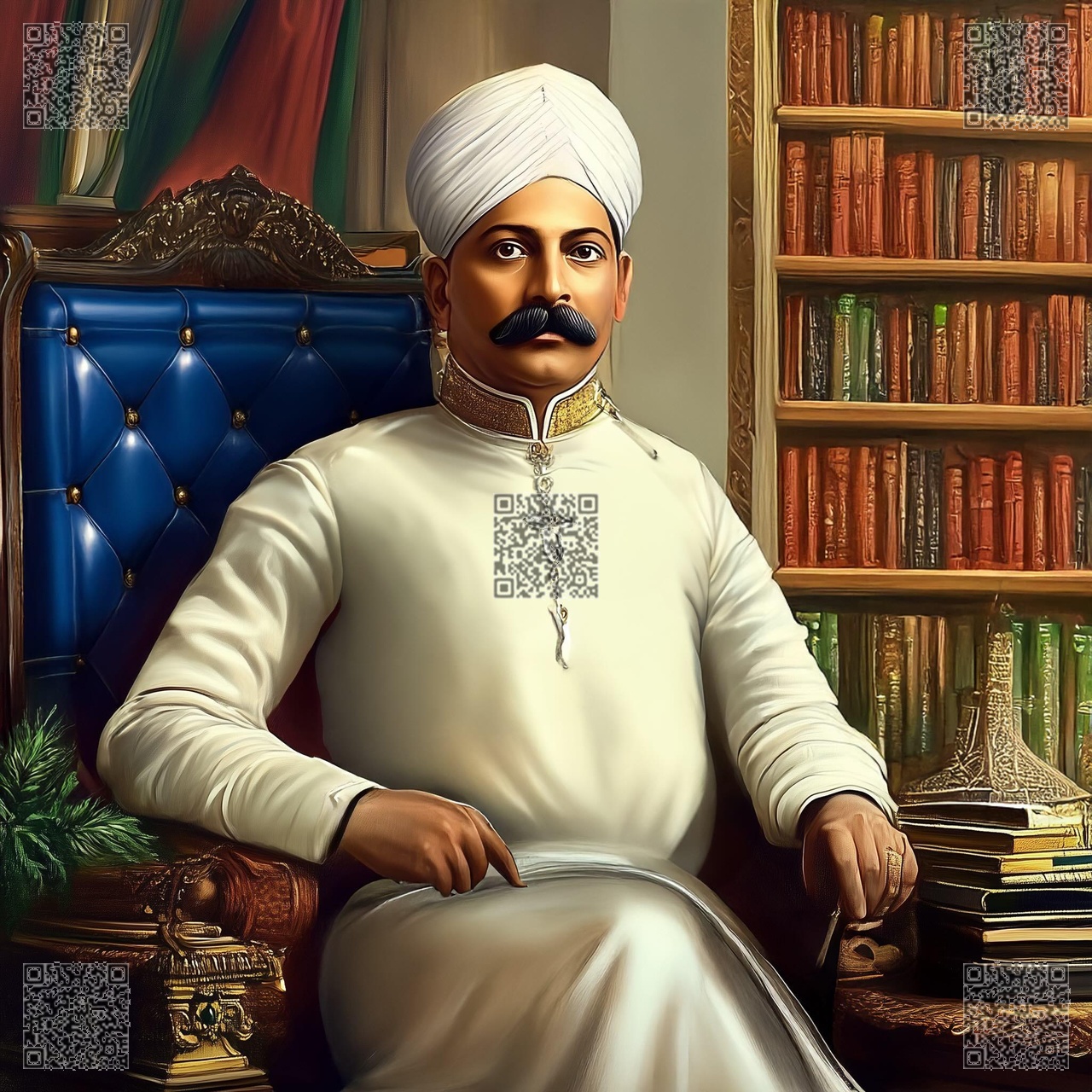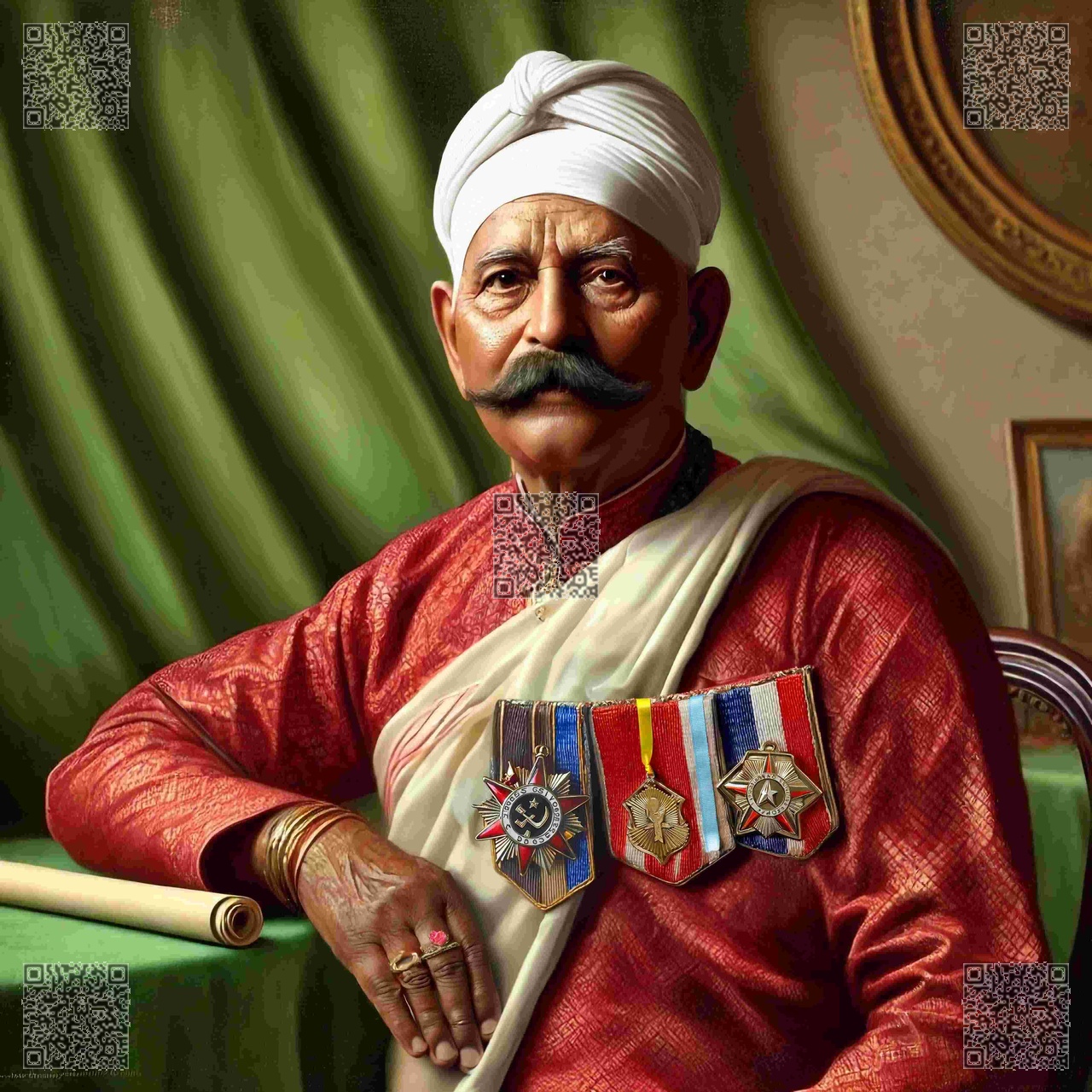(Diwan T Madhava Rao was NOT a member of the Alummoottil Family. However, he enjoyed very close ties with our family, and has significantly influenced our family history)
The relationship between Sir T. Madhava Rao, the Diwan of Travancore (1858–1872), and the Alummoottil family, particularly its Karanavar Kuthakkakkaran Sekharan Channar, represents a fascinating blend of collaboration, mutual respect, and shared governance. Beyond administrative cooperation, their bond also included shared experiences, personal interactions, and a shared vision for Travancore’s prosperity.
Sir T. Madhava Rao: A Visionary Administrator
Sir T. Madhava Rao served as the Diwan of Travancore from 1858 to 1872. When he assumed office, the state’s finances were in disarray, public treasuries were empty, and large arrears in salaries and other payments were pending. Within a few years, Madhava Rao transformed the state’s economy. By 1863, the state’s debts were cleared, and he proudly declared, “Travancore has no public debt now.”
Under his administration, numerous petty taxes and monopolies were abolished, land taxes were reduced, and salaries of public servants were raised significantly. His progressive financial measures not only stabilized the economy but also boosted the morale and efficiency of the administration. By the time he retired in 1872, the state had a reserve fund of forty lakhs of rupees.

Madhava Rao also brought advancements in education, legislation, public works, agriculture, and health. He introduced modern administrative practices, maintained detailed departmental records, and promoted female education and social reforms. His leadership earned Travancore the appellation “Model State of India.”
The Genesis of the Relationship
The association between Madhava Rao and the Alummoottil family began with Kuthakkakkaran Sekharan Channar’s ventures in the liquor-tax leasing business. By the time Madhava Rao assumed office, Channar had already established himself as a prominent lessee, having entered the trade during the earlier administration of Diwan V. Krishnaravu. However, it was during Madhava Rao’s tenure that Channar’s operations expanded significantly, owing to the supportive environment created by the Diwan’s policies.
Their professional association soon grew into a strong personal bond. Madhava Rao, impressed by Channar’s acumen in managing complex trade networks and his ability to foresee challenges, frequently sought Channar’s advice on administrative matters. For instance, during deliberations on restructuring the kalal-kuthakka system to improve state revenues, Madhava Rao reportedly consulted Channar on practical issues faced by leaseholders and incorporated his insights into policy decisions.
A Hunting Adventure in Africa
One of the most intriguing facets of their relationship was a shared hunting expedition to Africa. In 1867, Madhava Rao, inspired by reports of adventurous voyages and exotic wildlife, organized a hunting trip to East Africa and invited Channar to accompany him. The two men, along with a small entourage, set sail from Travancore and arrived in Zanzibar before venturing into the mainland’s savannahs.

The trip, though primarily recreational, became an opportunity for the two to strengthen their bond. While hunting lions and antelope, Madhava Rao reportedly admired Channar’s quick thinking and resourcefulness. On one occasion, when the group’s provisions were running low, Channar devised a plan to trade ivory from local merchants for additional supplies. Madhava Rao later described the trip as one of the most memorable experiences of his life, frequently recounting stories from it during official functions.
Frequent Visits to Alummoottil
Madhava Rao’s connection with the Alummoottil family extended beyond professional matters. During his circuit travels across Travancore, he often stayed at Alummoottil Nalukettu, where he was received with grand receptions. The Alummoottil estates, known for its architectural beauty and hospitality, became a favored retreat for the Diwan.
Channar ensured that Madhava Rao’s visits were marked by cultural and intellectual exchanges. Dinners were often accompanied by discussions on governance, trade, and Travancore’s future. On one such visit, Channar presented Madhava Rao with a detailed map of Travancore’s waterways, annotated with recommendations for improving the state’s transport network. Channar also laid out a cost benefit analysis of how converting some of the state road transport to cargo ships using these waterways would result in lower costs, faster lead-times and smoother supply chains. This map still exisits at Alummoottil with praising notes of Diwan, under his seal. These suggestions reportedly influenced the Diwan’s decision to initiate the construction of new canals and improve port facilities.
Invitations as Guest of Honor
The mutual respect between Madhava Rao and Channar was further reflected in their invitations to each other as guests of honor at significant events. Madhava Rao attended the consecration ceremony of the newly constructed Thekkadattu Mahadeva Temple, built under Channar’s supervision. During the event, Madhava Rao delivered a speech praising Channar’s contributions to Travancore’s religious and social landscape.
Similarly, Channar was invited to official ceremonies at the Travancore Secretariat, including the inauguration of new administrative buildings. On one such occasion, Madhava Rao publicly acknowledged Channar’s role in boosting state revenues and fostering economic growth. This public recognition solidified Channar’s status as a key figure in Travancore’s governance.
Administrative Support and Trust
Sir T. Madhava Rao’s support was instrumental in the success of the Alummoottil family’s ventures. The Diwan’s policies provided a structured framework for the liquor trade, which allowed Channar to focus on expanding his business. Moreover, the Diwan’s goodwill ensured that Channar received police protection during his frequent travels, which were fraught with risks. Liquor barrons across south Kerala are known for their underhand tactics, and monopolistic trade patterns of the Channar gained him a large number of enemies. However, his proximity to the Diwan acted as a deterrant.Transporting large amounts of silver coins and gold across waterways made Channar’s journeys vulnerable to robbery. However, the administration’s protective measures minimized these risks, enabling him to operate with relative security.
The trust between Madhava Rao and the Alummoottil family was mutual. Madhava Rao valued Channar’s contributions to the state’s revenue, while Channar respected the Diwan’s vision and administrative acumen. This relationship was not merely transactional but rooted in a shared commitment to the prosperity of Travancore.
Legacy of the Collaboration
The collaboration between Sir T. Madhava Rao and the Alummoottil family left an enduring legacy. The family’s success in the liquor trade not only brought significant revenue to the state but also elevated their status in Travancore’s society. Their wealth and influence allowed them to contribute to the community through various initiatives, including the construction of warehouses, temples, and other infrastructure.
Madhava Rao’s role in facilitating this success cannot be overstated. His progressive policies and emphasis on efficient administration provided the foundation for the Alummoottil family’s achievements. The trust and respect between Madhava Rao and the Alummoottil family exemplify the potential of collaborative governance in driving social and economic progress.
Conclusion
The relationship between Sir T. Madhava Rao and the Alummoottil family serves as a remarkable example of how mutual respect and collaboration between an administrator and a prominent family can lead to transformative outcomes. Madhava Rao’s visionary leadership and support enabled the Alummoottil family to thrive, while the family’s loyalty and contributions reinforced the effectiveness of Madhava Rao’s administration. Together, their shared experiences, adventures, and governance initiatives not only advanced the prosperity of Travancore but also set a precedent for the power of partnerships in governance and enterprise.



